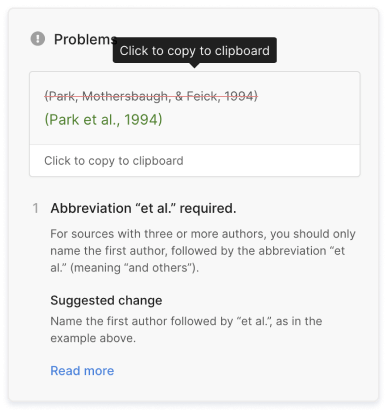How to Cite a Website in APA Style | Format & Examples
APA website citations usually include the author, the publication date, the title of the page or article, the website name, and the URL. If there is no author, start the citation with the title of the article. If the page is likely to change over time, add a retrieval date.
If you are citing an online version of a print publication (e.g. a newspaper, magazine, or dictionary), use the same format as you would for print, with a URL added at the end. Formats differ for online videos (e.g. TED Talks), images, and dissertations.
Use the buttons below to explore the format, or use our free APA Citation Generator to automatically create citations.
Cite a website in APA Style now:
Citing an entire website
When you refer to a website in your text without quoting or paraphrasing from a specific part of it, you don’t need a formal citation. Instead, you can just include the URL in parentheses after the name of the site:
One of the most popular social media sites, Instagram (http://instagram.com), allows users to share images and videos.
For this kind of citation, you don’t need to include the website on the reference page. However, if you’re citing a specific page or article from a website, you will need a formal in-text citation and reference list entry.
How to cite online articles
Various kinds of articles appear online, and how you cite them depends on where the article appears.
Online articles from newspapers, magazines, and blogs
Articles appearing in online versions of print publications (e.g. newspapers and magazines) are cited like their print versions, but with an added URL.
| APA format | Last name, Initials. (Year, Month Day). Article title. Publication Name. URL |
|---|---|
| APA reference entry | Greenhouse, S. (2020, July 30). The coronavirus pandemic has intensified systemic economic racism against black Americans. The New Yorker. https://www.newyorker.com/news/news-desk/the-pandemic-has-intensified-systemic-economic-racism-against-black-americans |
| APA in-text citation | (Greenhouse, 2020) |
The same format is used for blog posts. Just include the blog name where you would usually put the name of the magazine or newspaper.
| APA format | Last name, Initials. (Year, Month Day). Article title. Blog Name. URL |
|---|---|
| APA reference entry | Lee, C. (2020, February 19). A tale of two reference formats. APA Style Blog. https://apastyle.apa.org/blog/two-reference-formats |
| APA in-text citation | (Lee, 2020) |
Articles from online-only news sites
For articles from news sites without print equivalents (e.g. BBC News, Reuters), italicize the name of the article and not the name of the site.
| APA format | Last name, Initials. (Year, Month Day). Article title. Site Name. URL |
|---|---|
| APA reference entry | Rowlatt, J. (2020, October 19). Could cold water hold a clue to a dementia cure? BBC News. https://www.bbc.com/news/health-54531075 |
| APA in-text citation | (Rowlatt, 2020) |
Websites with no author
When a web page does not list an individual author, it can usually be attributed to an organization or government. If this results in the author name being identical to the site name, omit the site name, as in the example below.
| APA format | Organization Name. (Year, Month Day). Page title. Site Name. URL |
|---|---|
| APA reference entry | Scribbr. (n.d.). Academic proofreading & editing service. https://www.scribbr.com/proofreading-editing/ |
| APA in-text citation | (Scribbr, n.d.) |
If you can’t identify any author at all, replace the author name with the title of the page or article.
In the in-text citation, put the title in quotation marks if it is in plain text in the reference list, or in italics if it is in italics in the reference list. Note that title case is used for the title here, unlike in the reference list. Shorten the title to the first few words if necessary.
| APA format | Page title. (Year, Month Day). Site Name. URL |
|---|---|
| APA reference entry | The countdown: A prophecy, crowds and a TikTok takedown. (2020, October 19). BBC News. https://www.bbc.com/news/election-us-2020-54596667 |
| APA in-text citation | (The Countdown, 2019) |
Websites with no date
When a web page or article does not list a publication or revision date, replace the date with “n.d.” (“no date”) in all citations.
If an online source is likely to change over time, it is recommended to include the date on which you accessed it.
| APA format | Last name, Initials. (n.d.). Page title. Site Name. Retrieved Month Day, Year, from URL |
|---|---|
| APA reference entry | University of Amsterdam. (n.d.). About the UvA. Retrieved October 19, 2020, from https://www.uva.nl/en/about-the-uva/about-the-university/about-the-university.html |
| APA in-text citation | (University of Amsterdam, n.d.) |
How to cite from social media
As social media posts are usually untitled, use the first 20 words of the post, in italics, as a title. Also include any relevant information about the type of post and any multimedia aspects (e.g. videos, images, sound, links) in square brackets.
| APA format | Last name, Initials. (Year, Month Day). First 20 words of post [Description of multimedia aspects] [Type of post]. Site Name. URL |
|---|---|
| APA reference entry | American Psychological Association. (2020, October 14). When adjusted for inflation, the largest median salary increase between 2014 and 2018 was for psychology doctorate recipients who expected [Link with thumbnail attached] [Status update]. Facebook. https://www.facebook.com/AmericanPsychologicalAssociation/posts/10158794205682579 |
| APA in-text citation | (American Psychological Association, 2020) |
On some social media sites (such as Twitter), users go by usernames instead of or in addition to their real names. Where the author’s real name is known, include it, along with their username in square brackets:
In some cases, you’ll want to cite a whole social media profile instead of a specific post. In these cases, include an access date, because a profile will obviously change over time:
Frequently asked questions about APA Style citations
- What does an APA in-text citation for a website look like?
-
When citing a webpage or online article, the APA in-text citation consists of the author’s last name and year of publication. For example: (Worland & Williams, 2015). Note that the author can also be an organization. For example: (American Psychological Association, 2019).
If you’re quoting you should also include a locator. Since web pages don’t have page numbers, you can use one of the following options:
- Paragraph number: (Smith, 2018, para. 15).
- Heading or section name: (CDC, 2020, Flu Season section)
- Abbreviated heading: (CDC, 2020, “Key Facts” section)
- How do I cite a source with no page numbers in APA Style?
-
When you quote or paraphrase a specific passage from a source, you need to indicate the location of the passage in your APA in-text citation. If there are no page numbers (e.g. when citing a website) but the text is long, you can instead use section headings, paragraph numbers, or a combination of the two:
(Caulfield, 2019, Linking section, para. 1).
Section headings can be shortened if necessary. Kindle location numbers should not be used in ebook citations, as they are unreliable.
If you are referring to the source as a whole, it’s not necessary to include a page number or other marker.
- When should I include an access date in an APA citation?
-
APA Style usually does not require an access date. You never need to include one when citing journal articles, e-books, or other stable online sources.
However, if you are citing a website or online article that’s designed to change over time, it’s a good idea to include an access date. In this case, write it in the following format at the end of the reference: Retrieved October 19, 2020, from https://www.uva.nl/en/about-the-uva/about-the-university/about-the-university.html
Cite this Scribbr article
If you want to cite this source, you can copy and paste the citation or click the “Cite this Scribbr article” button to automatically add the citation to our free Citation Generator.
Caulfield, J. (2024, January 17). How to Cite a Website in APA Style | Format & Examples. Scribbr. Retrieved April 25, 2024, from https://www.scribbr.com/apa-examples/website/


